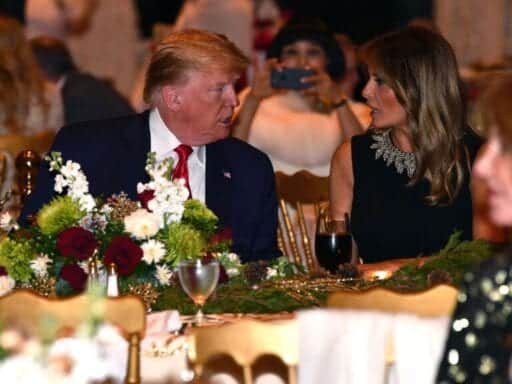FEC data shows how Trump’s properties, businesses, and family members are profiting from his reelection campaign.
President Donald Trump once bragged that if he ever ran for president, he’d be the first person to make money off it. According to his campaign’s filings with the Federal Election Commission, that prediction appears to be coming true.
Groups supporting Trump’s reelection have funneled about $1.7 million back into Trump-owned properties, businesses, and to the president’s family members, according to analysis from the New York Times. The Times report tracked the spending of the Trump campaign, the Trump Victory committee, the Republican National Committee, and a fourth entity called the Trump Make America Great Again Committee.
According to FEC filings, the Trump campaign steered $194,247.57 toward Trump’s private interests in the fourth quarter of last year. The other three groups supporting Trump’s re-election campaign made 150 separate payments to Trump-owned properties and businesses, totaling $600,000 over the three-month period.
New @FEC filing: Donald Trump’s 2020 re-election campaign paid $194,247.57 to Trump family members, properties & businesses in the final quarter of last year alone—steering over $1.8 MILLION in donations from presidential campaign donors to @realDonaldTrump‘s private interests. pic.twitter.com/ell9EtWkDH
— Anna Massoglia (@annalecta) February 1, 2020
According to Brendan Fischer, director of federal and FEC reforms at the Campaign Legal Center, the Trump campaign’s spending is nothing new. And the main problem is that Trump has refused to divest himself from his own business interests, opening the door to profiting off regular campaign operations.
“When there is a substantial amount of money that is going to properties owned by the candidate, it could raise questions about personal use,” he told Vox.
But, he says, just because it’s concerning doesn’t necessarily mean that the FEC will determine that the spending is illegal — and proving as much would be difficult.
In order to prove that campaign finance law has been violated, you’d have to show that payments to Trump’s properties exceeded fair market value for the expenditure. “The FEC’s approach to this kind of thing has generally been pretty hands off,” Fischer said. “That unless the amount of the payment is so oddly excessive, they’re not going to scrutinize whether the campaign could have gotten a better deal elsewhere.”
The FEC filing also showed that the campaign’s biggest expenditure in the quarter was digital advertising, for about $6 million. The campaign also spent about $1.24 million on legal fees as he’s battled back against several charges. In total, the Trump campaign has spent nearly $12.4 million on cases ranging from impeachment, former lover Stormy Daniels, fraud lawsuits against Trump University, and the Mueller investigation into Russian meddling in the 2016 election.
FEC data show some of those legal fees were paid to the Trump Organization.
Despite expenditures, Trump has a huge amount of cash on hand
Trump has been able to raise large sums of money as he gears up to defend his position in the White House. The four campaign organizations together raised about $154 million from October through December last year, and report $194 million in cash on hand.
Trump launched his 2020 re-election campaign just after taking office, the earliest of any modern president. Former President Barack Obama, for example, launched his re-election campaign in April 2011 and George W. Bush came under criticism for waiting until just 12 months before election day to officially launch his bid. As a result, Trump has enjoyed an early leg up on fundraising, as Vox’s Aaron Rupar explained last year:
According to the New York Times, at this point in the 2012 presidential election cycle, Barack Obama — who launched his reelection campaign on April 4, 2011 — had less than $2 million in the bank. Trump, by contrast, currently has a war chest of $41 million.
Trump’s strong fundraising is also reflected in the numbers for the Republican National Committee, which raised $45.8 million in the first quarter. The Democratic National Committee lags well behind that pace and was $4.6 million in debt at the end of January. When Trump’s fundraising is combined with the RNC’s pro-Trump efforts, he has a total of $82 million.
By contrast, Democrats running for president lag far behind Trump in the numbers. Bernie Sanders raised the most in the fourth quarter last year, coming in at $34.5 million. According to his campaign, Sanders had $18.2 million in cash on hand as of the end of 2019. Pete Buttigieg followed with a $24.7 million haul.
Former New York City Mayor Mike Bloomberg has declined to solicit donations, and his self-funded campaign ad spending has dwarfed his Democratic rivals, totaling about $200 million on advertising. Both Bloomberg and Trump each spent approximately $10 million for a Super Bowl ad Sunday night.
The Democratic candidates will be forced to continue spending what they’re raising in order to win over primary voters. Trump’s 2016 election win proved he has enough electoral support to win, and starting Monday in Iowa, the Democrats will be out to prove they can put together their own winning coalition. Even with Trump and Bloomberg currently dominating the ad wars, you can’t necessarily buy an election without broader support, but it certainly helps.
Author: Katelyn Burns
Read More



